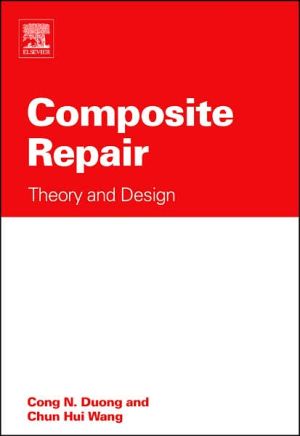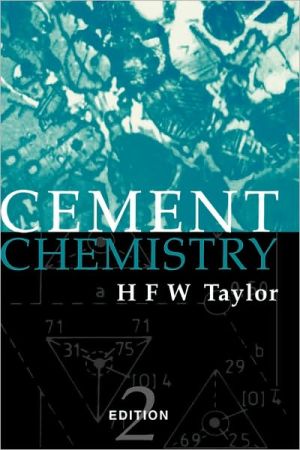Composite Repair: Theory and Design
Bonded composite repairs are efficient and cost effective means of repairing cracks and corrosion grind-out cavity in metallic structures, and composite structures sustained impact and ballistic damages, especially in aircraft structures. This book grew out of the recent research conducted at the Boeing Company and the Defence Science and Technology Organisation (DSTO, Australia) over the past ten years. Consequently it is predominately a compilation of the work by the authors and their...
Search in google:
Bonded composite repairs are efficient and cost effective means of repairing cracks and corrosion grind-out cavity in metallic structures, and composite structures sustained impact and ballistic damages, especially in aircraft structures. This book grew out of the recent research conducted at the Boeing Company and the Defence Science and Technology Organisation (DSTO, Australia) over the past ten years. Consequently this book is predominately a compilation of the work by the authors and their colleague at these two organizations on the design and analysis of composite repairs. Even though currently there are two edited books available on this particular topic, (Bonded Repair of Aircraft Structures, editors Baker and Jones, 1988, Martinus Nijhoff Publisher; Advances in Bonded Composite Repair of Metallic Structure, Baker et al, 2002, Elsevier), none have provided sufficient treatment of the design and analysis of bonded composite repairs. This book is therefore developed to fill in that gap by devoting its content entirely to the design and analysis of bonded repairs, focusing on the mathematical techniques and analysis approaches that are critical to the successful implementation of bonded repairs. The topics addressed in this book are developed to the extent that the presentation is sufficiently self-explanatory, and hence could serve as a state-of-the-art reference guide to engineers, scientists, researchers and practitioners interested in the underpinning design methodology and the modelling of composite repairs. Furthermore, this book can be used as a companion reference book to the United States Air Force (USAF) bonded repair guidelines (Guidelines for Composite Repair of Metallic Structure-CRMS, AFRL-WP-TR-1998-4113) and the Royal Australian Air Force (RAAF) Design Standard DEF(AUST)9005 that are currently used by most practitioners and field repair engineers through out the world, as well as for the new software called CRAS (Composite Repair of Aircraft Structures) developed by the Boeing Company and funded by the USAF.
Preface xiAcknowledgements xiiiDisclaimer xivIntroduction 1Objectives of Bonded Repairs and an Overview of the Repair Process 1Structural assessment 3Repair design 3Installation of the repair 7Objectives of This Book 8Review of Past and Current Work on Design and Analysis of Bonded Repair 8Basic Elements of Fracture Mechanics Theory 10Theory of Bonded Doublers and Bonded Joints 16Introduction 16Stress Analysis of Two-Sided Doublers and Double-Strap Joints 17Elastic analysis of two-sided doublers and double-strap joints 17Elastic-plastic analysis of two-sided doublers and double-strap joints 23Peel stresses in two-sided doublers and double-strap joints 28Stress Analysis of One-Sided Bonded Double and Single-Strap Joints 31Stage I: Solution for bending moment at ends and middle of overlap 33Stage II: Solution for induced adhesive peel stresses 38Stage III: Solution for induced adhesive shear stresses 45Consideration of Other Important Effects in Bonded Doublers and Joints 50Stress-free condition at the adhesive ends 51Corner singularity 53Stress concentration in adherends 59Triaxial stresses and plastic yielding 62Failure Criteria for Bonded Doublers and Joints 65Summary 68Fundamental Concept of Crack Patching 69Introduction 69Formulation and Notation 71Symmetric or Fully Supported One-Sided Repairs 73Stage I: Load attraction by patch 73Stage II: Stress intensity factor 80The effect of plastic adhesive 82The effect of finite crack size 83The effect of mixed mode loading 86One-Sided Repairs 87Thermal Stresses 92Summary 94Mathematical Theory of Supported One-Sided Crack Patching or Two-Sided Crack Patching 95Introduction 95Stage I: Load Attraction 95Equivalent inclusion method 97Inclusion problem with polynomial eigenstrains 100Solution of the load attraction problem 107Load attraction with thermal effects 110Stage II: Fracture Analysis 115Cracked sheet displacements and stresses 118Composite patch displacements and stresses 122Stress intensity factor evaluation 130Numerical Illustrations 131Thermal Constraints 138Summary 145Approximate Theory of Unsupported One-Sided Crack Patching 146Introduction 146Stage I: Geometrically Linear Analysis 147Inclusion with constant eigencurvature 147Geometrically linear analysis of polygonal patch 152Geometrically Nonlinear Analysis of Stage I 159Thermal stresses in polygonal patch 162Patch spanning across the entire plate's width under purely mechanical loading 176Polygonal patch under combined thermo-mechanical loading 183Stage II: Fracture Analysis Using Crack-bridging Model 189Determination of spring constants 192Fracture analysis by crack-bridging model 197Numerical solutions of integral equations 201Illustrative examples 205Thermal Residual Stresses Resulting from Bonding 209Rose's or Barneveld-Fredell's curing model 209Duong and Yu's curing model 209Wang and Erjavec's curing model 210Characterization of Fatigue Crack Growth in One-Sided Patching 214Summary 214Analytical Approach to Repairs of Corrosion Grind-Outs 216Introduction 216Fundamental Concepts 216Eshelby solution for elliptical inhomogeneities 217Analytical solution of elliptical patches 220Formulas for a special case of an elliptical isotropic patch with a Poisson's ratio same as skin 224General Solution of Polygon-Shaped Patches 229Polygonal inhomogeneity with variable stiffness 229Repair over an elliptical grind-out 232Summary 247Bond-line Analysis at Patch Ends 248Introduction 248One-Dimensional Analysis of Tapered Patches and Doublers 248Mathematical formulation and two-step solution method 249Solution for nonlinear moment distribution along the joint 249Solutions for peel and shear stresses in the adhesive 253Numerical examples 261One-Dimensional Analysis of Tapered Patches and Doublers Including Effects of Thermal Mismatch and Adhesive Plasticity 270Extension to include the effect of thermal mismatch 271Extension to include the effect of adhesive plasticity 276Approximate Method for Adhesive Stresses at Patch End in a One-Sided Repair 277Approximate Method for Adhesive Stresses at Patch End in a Two-Sided Repair 278Summary 279Fatigue Crack Growth Analysis of Repaired Structures 280Introduction 280Crack-Closure Analysis of Repaired Cracks 281Crack closure of repaired cracks under small-scale yielding 281Crack closure of repaired cracks under large-scale yielding 284Overload Effect and Validation Using Finite Element Method 289Comparison with Experimental Results 292Summary 299A Preliminary Design Approach for Crack Patching 300Introduction 300Basic Analysis Methods Used in the Preliminary Design Approach 301Analysis method for a repair subjected only to mechanical loads 301Analysis method for a repair subjected to thermo-mechanical loads 304Design Criteria 310Design criteria for cracked skin 311Design criteria for patch 312Design criteria for adhesive 313Material Selection 314Patch materials 314Adhesive materials 315Preliminary Design Procedure 320Design procedure for a repair subjected only to mechanical loads 323Design procedure for a repair subjected to thermo-mechanical loads 325An Illustrative Example Using Design Process 332Loading conditions 333Design parameters 333Summary 335A Preliminary Design Approach for Corrosion Repairs 336Introduction 336Basic Analysis Methods Used in the Preliminary Design Approach 337Analysis method for a repair subjected only to mechanical loads 337Analysis method for a repair subjected to thermo-mechanical loads 340Design Criteria 345Design criteria for corroded skin or substrate 345Design criteria for patch 345Design criteria for adhesive 346Preliminary Design Procedure 346Summary 348Experimental Verifications of Analytical Methods 349Introduction 349Fatigue Crack Growth Tests and Method Validation 350Fatigue crack growth tests 350Characterization of fatigue crack growth in one-sided and two-sided repairs 351Fatigue crack growth analysis 360Comparison between analytical predictions and test results 362Load Attraction Tests and Method Validation 374Load attraction tests 374Comparison between analytical prediction and test results 376Summary 377Repair of Sonic Fatigue 382Introduction 382Structural Response to Acoustic Loading 386Analysis of Damped Repairs 387Dynamic analysis of layered beams 387Influence of structural damping 388Static and dynamic responses of damped repair 390Stresses and stress intensity factors in the repaired skin 391Fatigue Crack Growth Analysis 393Optimization of Damped Repairs 395An Illustrative Example 395Repair Analysis Methods Accounting for Secondary Effects 402Effect of Tapering on Load Attraction of Bonded Patches 402Effect of Patches in Proximity on Load Attraction 406Effect of Adherend Shear Deformation on Repair Efficiency 412Concluding Remarks 419Introduction to CRAS Software 421References 442Index 456








